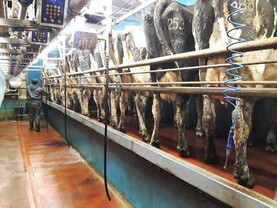A new roadmap for agriculture and climate change is targeting ambitious cuts in methane, ammonia and nitrogen use on Irish farms over the coming decades.
On Wednesday, the Department of Agriculture published its new Ag Climatise road map, which sets out a total of 29 actions to be adopted over the coming years that will help Irish agriculture achieve carbon neutrality by 2050.
The standout actions listed are a reduction in methane emissions from Irish livestock, an ambitious 10% cut in ammonia emissions by 2030 as well as a 20% cut in elemental nitrogen usage on Irish farms by 2030 in line with the EU’s Farm to Fork plan.
Nitrogen
Under its Ag Climatise road map, the Department wants to see a 20% cut in elemental nitrogen use on Irish farms from its current level above 408,000t down to 325,000t by 2030. The road map has set an interim reduction target of 350,000t of nitrogen use by 2025.
To achieve this reduction, the Department plans to encourage greater uptake of clover in grass reseeds, and will also roll out a new national liming programme that will seek to more than double the amount of lime spread on Irish farms to 2m tonnes per annum in the coming years.
The aim of this increase in liming will be to improve soil fertility on Irish farms, and by extension increase nitrogen use efficiency in soils. In this way, farmers will need to spread less nitrogen to grow the same amount.
The Department is also clear that there is a balance to be struck when it comes to reducing nitrogen use on Irish farms as it cannot lead to a scenario where Ireland is forced to increase animal feed imports due to lost fodder production on farms.
Ammonia
The Ag Climatise road map also sets a very challenging target of reducing ammonia levels from Irish farms by 10% from the current level of 119,000t down to 107,500t by 2030.
To achieve this, the Department plans to prohibit the sale of straight urea by 2023 so that all urea products sold in Ireland by then are protected urea, which is normal urea coated with an inhibitor substance that dramatically reduces ammonia losses when spreading.
The Department also aims to have 65% of CAN fertiliser products treated with ammonia inhibitors by 2030.
The other big change required on Irish farms to meet ammonia targets will be the mass adoption of low-emission slurry spreading (LESS) technology.
Roughly 30% of slurry will be applied with LESS systems next year. The Department has targeted increasing this figure to 60% by 2020, 80% by 2025 and 90% by 2027.
Additionally, the Department states that it wants the maximum level of crude protein in animal feed set at 16% for pigs and 15% for livestock, which will also help minimise ammonia losses.
Methane
On methane, the Department’s road map says it wants the sector to be carbon neutral by 2050, whereby all methane emissions from livestock are offset by carbon sequestration from forestry, woodlands, hedgerows and soils.
There is an acknowledgement that there will always be some form of greenhouse gas emissions from farming and food production but that increased carbon sequestration can offset these emissions.
To reduce methane emissions, the Ag Climatise road map is targeting improved animal breeding as outlined in the Teagasc MACC and continued research into methane inhibiting feed additives, which is still at an early stage.
Other actions
Other actions in the Ag Climatise road map which catch the eye include a proposal to establish an on-farm carbon trading scheme, a commitment to examine the potential for a biomethane industry in Ireland and rewet at least 40,000ha (100,000ac) of peat soils to reduce CO2 losses.






 This is a subscriber-only article
This is a subscriber-only article










SHARING OPTIONS: